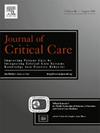评价溴隐亭对急性神经损伤患者退烧的作用:一项回顾性队列研究
IF 2.9
3区 医学
Q2 CRITICAL CARE MEDICINE
引用次数: 0
摘要
背景/目的发热在神经损伤患者中很普遍,传统上采用退烧药和表面降温方式治疗。多巴胺(D2)受体激动剂,如溴隐亭,已显示出治疗中枢性发热的益处;然而,目前还没有在这一人群中使用溴隐亭的指南。本研究的目的是评价溴隐亭联合对乙酰氨基酚与单独对乙酰氨基酚治疗急性神经损伤患者发热的安全性和有效性。方法本研究是一项回顾性队列研究,研究对象是神经科学重症监护室(Neuro ICU)收治的急性神经系统损伤患者,这些患者每8 h服用溴隐汀5mg加对乙酰氨基酚(BROMO)或对乙酰氨基酚单用(APAP)作为发烧的指指。主要终点是溴隐亭和对乙酰氨基酚或单独使用对乙酰氨基酚72小时后温度(°C)的降低。结果共纳入67例患者;BROMO组28例,APAP组39例。与APAP组相比,BROMO组在72 h时的温度显著降低(- 0.86°C vs - 0.39°C, p = 0.017)。两组均未发现不良反应。结论溴隐亭5 mg / 8 h联合对乙酰氨基酚用于神经损伤患者发热治疗是安全的。需要更多的前瞻性、多中心研究来进一步阐明溴隐亭在神经内科ICU治疗发热中的作用。本文章由计算机程序翻译,如有差异,请以英文原文为准。
Evaluation of bromocriptine for the reduction of fever in patients with acute neurologic injury: A retrospective cohort study
Background/objective
Fever is prevalent among patients with neurologic injury and has traditionally been treated with antipyretics and surface cooling modalities. Dopamine (D2) receptor agonists, such as bromocriptine, have shown a benefit for the treatment of central fever; however, there are currently no guidelines for the use of bromocriptine in this population. The purpose of this study was to evaluate the safety and efficacy of bromocriptine plus acetaminophen compared to acetaminophen alone for the treatment of fever in patients with acute neurologic injury.
Methods
This was a retrospective cohort study of patients admitted to the neurosciences intensive care unit (Neuro ICU) with an acute neurologic injury who received bromocriptine 5 mg every 8 h plus acetaminophen (BROMO) or acetaminophen alone (APAP) for the indication of fever. The primary outcome was reduction of temperature (°C) 72 h after initiation of bromocriptine and acetaminophen or acetaminophen alone.
Results
A total of 67 patients were included; 28 patients were included in the BROMO group and 39 patients in the APAP group. There was a significant reduction in temperature at 72 h in the BROMO group compared to the APAP group (−0.86 °C vs −0.39 °C, p = 0.017). No adverse effects were noted in either group.
Conclusion
This study found that bromocriptine 5 mg every 8 h is safe when used in combination with acetaminophen for fever management among patients with neurologic injury. Additional prospective, multi-center studies are needed to further elucidate the role of bromocriptine in the treatment of fever in the Neuro ICU.
求助全文
通过发布文献求助,成功后即可免费获取论文全文。
去求助
来源期刊

Journal of critical care
医学-危重病医学
CiteScore
8.60
自引率
2.70%
发文量
237
审稿时长
23 days
期刊介绍:
The Journal of Critical Care, the official publication of the World Federation of Societies of Intensive and Critical Care Medicine (WFSICCM), is a leading international, peer-reviewed journal providing original research, review articles, tutorials, and invited articles for physicians and allied health professionals involved in treating the critically ill. The Journal aims to improve patient care by furthering understanding of health systems research and its integration into clinical practice.
The Journal will include articles which discuss:
All aspects of health services research in critical care
System based practice in anesthesiology, perioperative and critical care medicine
The interface between anesthesiology, critical care medicine and pain
Integrating intraoperative management in preparation for postoperative critical care management and recovery
Optimizing patient management, i.e., exploring the interface between evidence-based principles or clinical insight into management and care of complex patients
The team approach in the OR and ICU
System-based research
Medical ethics
Technology in medicine
Seminars discussing current, state of the art, and sometimes controversial topics in anesthesiology, critical care medicine, and professional education
Residency Education.
 求助内容:
求助内容: 应助结果提醒方式:
应助结果提醒方式:


